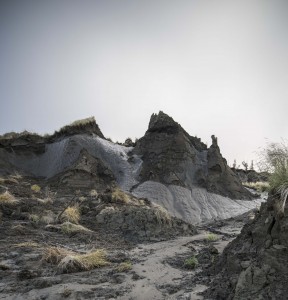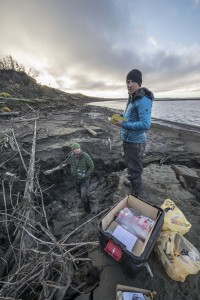23 April 2015
WASHINGTON, D.C. – Carbon, held in frozen permafrost soils for tens of thousands of years, is being released as Arctic regions of the Earth warm and is further fueling global climate change, according to a new study.
The new research finds that single-cell organisms called microbes are rapidly devouring the ancient carbon being released from thawing permafrost soil and ultimately releasing it back into the atmosphere as carbon dioxide. Increased carbon dioxide levels cause the Earth to warm and accelerate thawing, according to Robert Spencer, assistant professor of oceanography at Florida State University in Tallahassee, and lead author of the new paper accepted for publication in Geophysical Research Letters, a journal of the American Geophysical Union.
“When you have a huge frozen store of carbon and it’s thawing, we have some big questions,” said Spencer. “The primary question is when it thaws, what happens to it? Our research shows this ancient carbon is rapidly utilized by microbes and transferred to the atmosphere, leading to further warming in the region and therefore more thawing. So we get into a runaway effect.”
FSU professor Robert Spencer discusses the new study in Geophysical Research Letters (Credit: Florida State University)

A permafrost exposure at Duvanni Yar on the banks of the Kolyma River in Siberia. As the region warms these frozen soils thaw creating the unique landscape of towering and collapsing soil as the ice wedges disappear. A new study finds that carbon, held in frozen permafrost soils for tens of thousands of years, is being released as Arctic regions of the Earth warm and is further fueling global climate change.
Credit: Aron Stubbins
Spencer and a team of researchers first began looking at this issue of what happened to the carbon as permafrost thawed several years ago. There was a gap in the scientific literature because terrestrial scientists had found that permafrost was thawing and thus releasing long-stored carbon. But, aquatic scientists found no evidence of that ancient carbon at the mouths of major rivers leading to the Arctic Ocean.
So, where did the carbon go?
The simple answer is that it became food.
The more complex answer provides an interesting glimpse into how some of the smallest living organisms can have a major effect on the planet. Microbes, single-cell organisms that are too small for the human eye to see, are the oldest form of life on Earth and carbon is a rich food source for them.
Scientists weren’t finding carbon at the mouth of major Arctic rivers because it was already consumed and released into the atmosphere.
“This material is very attractive to these microbes as a food source,” Spencer said. “As permafrost thaws, microbes are going to use this carbon with clear ramifications for climate change.”
To conduct the new study, Spencer led a team of researchers who spent more than three months between 2012 and 2014 studying thawing permafrost in Siberia. Permafrost in the region is extremely deep — more than 30 meters (100 feet) in some places — and has remained frozen for tens of thousands of years.

Robert Spencer, of Florida State University, and Paul Mann of Northumbria University, sample permafrost thaw dominated streams in Siberia to examine the fate of the recently mobilized carbon in these streams.
Credit: Aron Stubbins
At 19 different sites in the Siberia region, Spencer and his colleagues collected hundreds of water samples and conducted experiments to determine what portion of the carbon pool microbes were using as a food source — the ancient carbon coming from the thawed permafrost or new sources.
Spencer acknowledged it is exceptionally difficult for scientists to capture that process in real time, but future research will take his team to small streams dominated by permafrost thaw to see if they could quantify permafrost carbon inputs before microbes gobble it up.
“We have to capture this material as soon as it thaws because that’s where we see its unique compositional features which make it so attractive to microbes,” he said.
Spencer’s research is funded by the National Science Foundation. Other institutions contributing to the research are Northumbria University in the United Kingdom, University of Oldenburg in Germany, ETH Zurich in Switzerland, Woods Hole Research Center in Massachusetts, the Russian Academy of Science and the University of Georgia.
###
The American Geophysical Union is dedicated to advancing the Earth and space sciences for the benefit of humanity through its scholarly publications, conferences, and outreach programs. AGU is a not-for-profit, professional, scientific organization representing more than 60,000 members in 139 countries. Join the conversation onFacebook, Twitter, YouTube, and our other social media channels.
Notes for Journalists
Journalists and public information officers (PIOs) of educational and scientific institutions who have registered with AGU can download a PDF copy of the article by clicking on this link: http://onlinelibrary.wiley.com/wol1/doi/10.1002/2015GL063498/abstract?campaign=wlytk-41855.5282060185
Or, you may order a copy of the final paper by emailing your request to Nanci Bompey at [email protected]. Please provide your name, the name of your publication, and your phone number.
Neither the papers nor this press release is under embargo.
“Detecting the Signature of Permafrost Thaw in Arctic Rivers”
Authors:
Robert G. M. Spencer: Department of Earth, Ocean and Atmospheric Science, Florida State University, Tallahassee, FL, USA;
Paul J. Mann: Department of Geography, Northumbria University, Newcastle-upon-Tyne, UK;
Thorsten Dittmar: Institute for Chemistry and Biology of the Marine Environment, University of Oldenburg, Oldenburg, Germany;
Timothy I. Eglinton: Geological Institute, ETH-Zürich, Zürich, Switzerland;
Cameron McIntyre: Geological Institute, ETH-Zürich, Zürich, Switzerland; and Laboratory for Ion Beam Physics, Department of Physics, ETH-Zürich, Zürich, Switzerland;
R. Max Holmes: Woods Hole Research Center, Falmouth, MA, USA;
Nikita Zimov: North-East Science Station, Far-Eastern Branch of Russian Academy of Science, Cherskiy, Republic of Sakha, Russia;
Aron Stubbins: Skidaway Institute of Oceanography, University of Georgia, Savannah, GA, USA.
Contact Information for the Authors:
Robert Spencer: +1 (850) 644-9205, [email protected]
Nanci Bompey
+1 (202) 777-7524
[email protected]
Florida State University Contact:
Kathleen Haughney
+1 (850) 644-1489
[email protected]